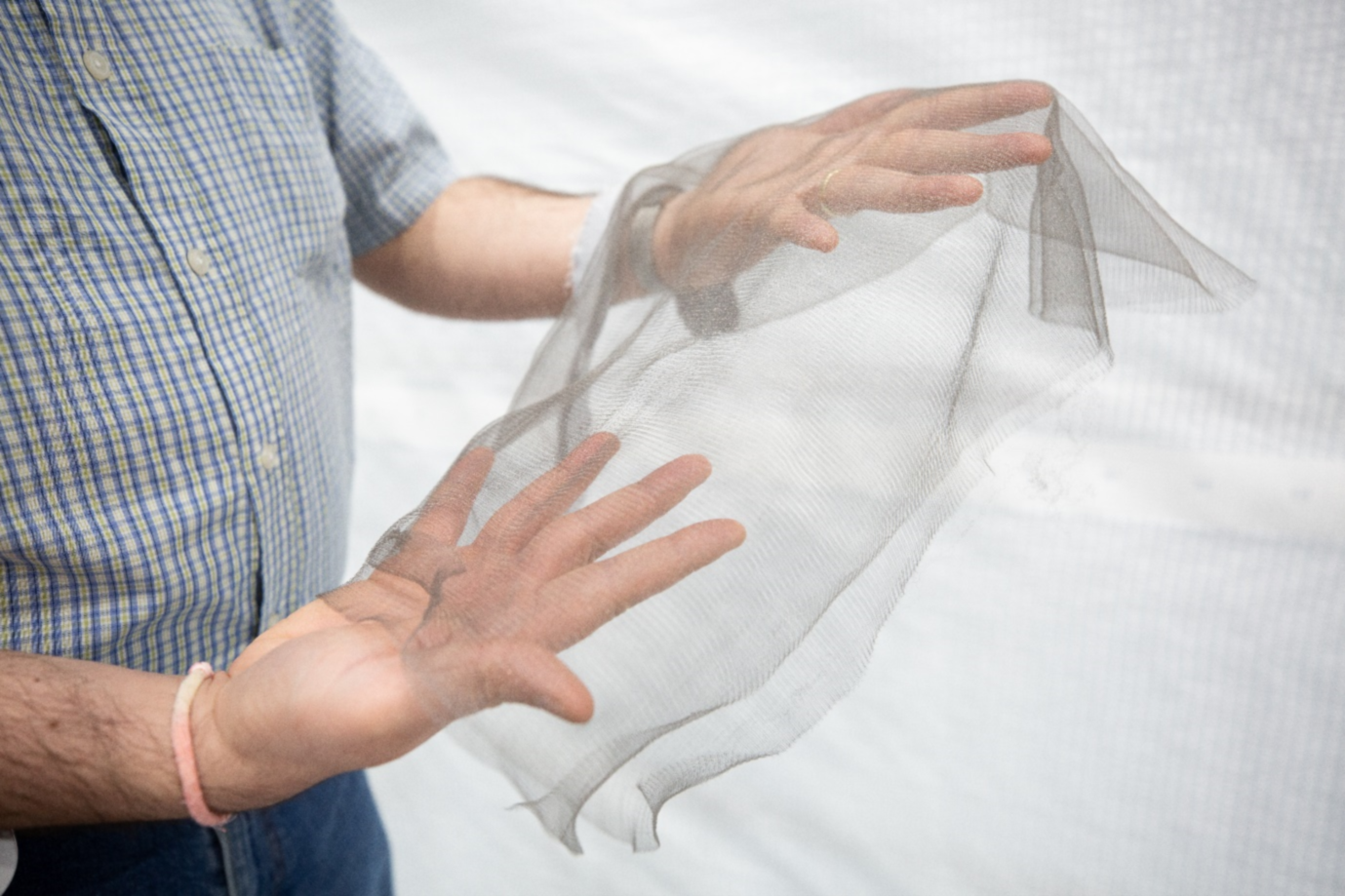Oxford Space Systems commissions industrial scale knitted mesh production facility
 Oxford Space Systems has developed a metal mesh manufacturing facility at their Harwell base, manufacturing foldable surfaces for their reflector antennas. The project, backed by the European Space Agency (ESA)’s ARTES Core Competitiveness programme, will enable the company to meet growing market demand for high-specification antennas.
Oxford Space Systems has developed a metal mesh manufacturing facility at their Harwell base, manufacturing foldable surfaces for their reflector antennas. The project, backed by the European Space Agency (ESA)’s ARTES Core Competitiveness programme, will enable the company to meet growing market demand for high-specification antennas.
Metal mesh reflector surfaces are a key component of Oxford Space Systems’ reflector antenna products, where high reflectivity and mechanical compliance are essential to achieve efficient stowage volumes and high radio frequency (RF) performance. The global supply of metal mesh for satellite reflectors is limited, which in turn has an impact on the overall cost of satellite payload production and operation. Bringing production in-house has not only given Oxford Space Systems a competitive advantage but also the flexibility to react quickly to customer demand for both small and large reflector antennas, and to drive further innovation.
In order to establish the new production facility, the company brought in technology and expertise from the textile industry, with industrialisation expert Dr Amool Raina and knitting technician Ms. Majken Herold working closely with mechanical and RF engineers throughout the process. The challenge for this project was to develop a knitted metal mesh, that could be manufactured in-house at an industrial scale. It also needed to be flexible enough to allow the antenna primary reflector to be wrapped around a central hub and retain its structural integrity and surface characteristics after deployment.
Commenting on her experience at Oxford Space Systems, Knitting Technician Majken Herold said “using cross-disciplinary expertise from the traditional textile industry has allowed OSS to significantly accelerate its product development process. I am happy to see my textile technology knowledge being applied to the development of space hardware.”
Upon sourcing industrial knitting equipment, Oxford Space Systems developed proprietary techniques for handling and feeding yarn into the knitting machine. The company demonstrated a stable and repeatable knitting process using a variety of different metallic yarns. When it came to selecting the knitting architecture for the mesh, Oxford Space Systems employed a different approach to knitting as compared to other manufacturers. As well as creating a competitive advantage, the company’s knitted reflectors offer several key benefits. The ability to produce tubular fabric means that 3D structures, with minimal or no seams, are possible. Processing times are shorter given the use of high-performance knitting machines, capable of producing complex knitted structures.
“With support from the ESA-ARTES programme, within a short span of 18 months, Oxford Space Systems has achieved a critical milestone, through the development and industrialisation of its proprietary metal mesh, a unique, first in Europe, in-house capability for a deployable space antenna company,” said Dr Amool Raina, Senior Production Manager and Head of R&D at OSS.
As a part of this activity, several distinct mesh patterns were selected for testing for RF reflectivity at ESA’s European Space Research and Technology Centre (ESTEC) in the Netherlands, with a reduced set of patterns taken forward for Passive Inter-Modulation (PIM) behaviour characterisation at ESA’s High-Power RF Laboratory hosted by the Valencia Space Consortium (VSC) in Spain. After eighteen months in development and testing, Oxford Space Systems mesh (Ox-Mesh-WF) is now ready to be used across all antennas, with the initial focus on their Wrapped Rib Antenna (WRA). In-house production gives the company the capability to be self-sufficient in terms of manufacturing and integration of primary reflector surfaces, with reduced production costs and a significantly quicker time to market for their antennas. The first launch of an antenna with the new mesh is expected to take place in the coming months.
Reflecting on the project, Paul Greenway, Space Segment Engineer at ESA said “we are proud to have supported Oxford Space Systems with this successful ARTES Core Competitiveness activity. The capability and know how achieved will enable all up reflectors to be produced, extending the reach of European industry in providing novel antenna solutions for space.”
The company’s Chief Executive Officer Sean Sutcliffe said “with the metal-mesh facility now fully operational and the production of gold-plated mesh in-house, this programme supported by ARTES has been a key enabler in developing Oxford Space Systems’ capability to deliver high performance deployable antennas for the space industry and to continue to innovate.”


